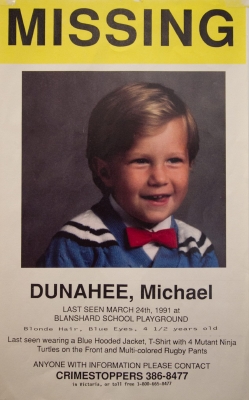
Police continue to hunt down new tips.
The name Michael Dunahee is etched in the mind of anyone who lived in Victoria at the time of his disappearance.
Twenty-five years ago this month, four-year-old Michael was abducted from a playground in the quiet Victoria neighbourhood of Esquimalt, while his mother, Crystal Dunahee, played touch football just yards away.
“It was an ordinary day. No different than any other,” says Crystal. “Michael asked if he could go to the park just beside, and I said yes.”
“I told him to wait for his dad, and not to go anywhere,” she says, adding that Michael knew not to speak with strangers.
The field where Crystal played football each weekend was less than 100 yards from the playground. According to Crystal, police believe Michael never made it that far.
“We think he was abducted in the parking lot,” she says, noting that the playground couldn’t have been more than 75 yards from where they parked their van.
Crystal and her Husband Bruce Dunahee say they’ll never forget the terror of searching for their son, or realizing his disappearance was more than just a child who walked away from a playground.
Yet, as difficult as it was, they realized then that they needed to remain strong, and allow police to conduct their investigation.
“We had another child at home, a daughter, that we needed to take care of,” says Crystal. “She needed us, and that was important.”
The investigation
Retired Insp. Det. Fred Mills of the Victoria Police Department was responsible for the initial investigation.
Still haunted by the case, Mills wonders if there’s anything he might have missed, anything he overlooked.
“It’s something you always ask yourself,” says Mills. “But you do the best you can with the knowledge you have, and eventually you need to move on.”
In addition to standard investigative practices, Mills deployed a team of officers to Quantico, Va to consult the FBI’s behavioral analysis unit – a first for Victoria police.
Disheartening as it was for Mills not find answers to Michael’s disappearance, he sees the passing of the investigation from one detective to the next as a positive development. He also recognizes the importance of keeping Michael’s story alive and in the public eye.
“You could have a breakthrough tomorrow,” says Mills. “Every time an anniversary comes up and it’s out there in the media they get more tips.”


Michael in 1991, left. Age-enhanced depiction of what Michael might have looked like in 2012, right. www.michaeldunahee.ca
Still hunting
As with all unsolved cases involving missing children, Michael’s case remains an open investigation.
Const. Keith Lindner, now responsible for Michael’s file, says police continue to investigate new leads, and that he remains in close contact with Michael’s family.
He also stresses the significance of Michael’s disappearance to the community.
“You say the name Dunahee, and everyone knows,” says Lindner. “I’m in my 30th year and it’s hands down the most emotional file I’ve ever been involved in.”
Michael’s disappearance reverberates well beyond Victoria. News of his abduction was broadcast across North America on major news networks and on programs such as America’s Most Wanted.
“I’ve heard people describe it as a loss of innocence,” says Lindner. “And I’ve yet to come up with a better description than that.”
Today, investigators use social media, Amber alerts and age-enhanced photography to solve crimes. Though none of these tools existed at the time of Michael’s disappearance, they are now being used to spread awareness of Michael’s case in the hope that someone, somewhere, knows something.
“Unfortunately, we don’t know what happened to Michael,” says Lindner. “But what I can tell you is that we’re not going to give up.”
The CBC’s Jean Paetkau has produced an excellent radio documentary including the voices of Crystal Dunahee and retired Insp. Det. Fred Mills. To listen, click here.
-30-


